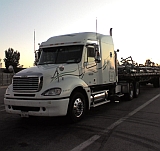 |
|

06-03-2007, 12:06 AM
|

Rookie
Thread Starter
Join Date: Nov 2006
Location: canada
Posts: 13
Mentioned: 0 Post(s)
Tagged: 0 Thread(s)
|
 flatbed questions?
flatbed questions?
hi all,
recently my employer has taken on some flatbed activity, and has asked me to drive the flatbed, its construction items,.e.g.(drywall,plywood,wood,specially made cabinets, well house items.) as for securing this items? every how many feet must the straps come across to the other side by law?,as for securement all i see on the flatbed are straps, and i have not DONE FLATBED BEFORE. all i have seen the other drivers use are the straps for securement of the items.
please give me as many details as you can on hauling items on a flatbed or even a website i can go read up on.
i would hate to take the load through the weigh scale and get nailed with a fine. or worse THE LOAD FALLS OFF.
ty all
|


06-03-2007, 01:07 AM
|

Senior Board Member
Join Date: Sep 2006
Location: Indianapolis,In
Posts: 887
Mentioned: 0 Post(s)
Tagged: 0 Thread(s)
Mentioned: 0 Post(s)
Tagged: 0 Thread(s)
|
 Re: flatbed questions?
Re: flatbed questions?
Quote:
|
Originally Posted by mtlstar
hi all,
recently my employer has taken on some flatbed activity, and has asked me to drive the flatbed, its construction items,.e.g.(drywall,plywood,wood,specially made cabinets, well house items.) as for securing this items? every how many feet must the straps come across to the other side by law?,as for securement all i see on the flatbed are straps, and i have not DONE FLATBED BEFORE. all i have seen the other drivers use are the straps for securement of the items.
please give me as many details as you can on hauling items on a flatbed or even a website i can go read up on.
i would hate to take the load through the weigh scale and get nailed with a fine. or worse THE LOAD FALLS OFF.
ty all
|
Say its drywall or lumber; I would have to say I would use 3 straps for the front and rear stacks and 2 straps for the other stacks. Unless of coarse they are double stacked, then 3 straps for every stack. As far as the cabinets I would have to know the dimensions and how they are packaged. Remember you can never use to many straps. If you do use to many nothing happens so better safe than sorry. You will learn in time what you need!
__________________

|

06-03-2007, 01:33 AM
|

Senior Board Member
Join Date: Sep 2005
Location: Western Arkansas
Posts: 606
Mentioned: 0 Post(s)
Tagged: 0 Thread(s)
Mentioned: 0 Post(s)
Tagged: 0 Thread(s)
Mentioned: 0 Post(s)
Tagged: 0 Thread(s)
|
It really does depend on what is on the trailer and how it's loaded and what the weight is. FMCSA Cargo Securement Laws - That is the FMCSA's rules and regulations on securing cargo. They are the basic minimum to be legal for DOT. As ssouthlaw said, you can't use too many straps. From what you listed, you should be fine with straps only, I wouldn't worry much about chains, but the idea for placement is the same.
You can always ask another flatbedder where you are unloading as well. Most are willing to help if you are willing to learn.
Good luck!
__________________
"Sticks and stones may break my bones, but straps and chains excite me!" :lol: ~ Flatbedder's Credo
|

06-03-2007, 01:34 AM
|

Senior Board Member
Join Date: Jan 2005
Location: East Central IL between the corn and the beans
Posts: 4,977
Mentioned: 0 Post(s)
Tagged: 0 Thread(s)
Mentioned: 0 Post(s)
Tagged: 0 Thread(s)
Mentioned: 0 Post(s)
Tagged: 0 Thread(s)
Mentioned: 0 Post(s)
Tagged: 0 Thread(s)
|
To answer your question:
You must have at least 1 strap or chain for every 10 feet of load.
Of course, every item/skid needs to have at least 1 strap on it. A single strap can be used to secure items that are next to each other assuming the total weight of all items does not exceed the working load limit of the strap or chain.
How many straps you use will be determined by:
The weight of the item.
The length of the item.
Working load limit of your strap or chain.
Total separate items on the trailer.
Here is one other thing to keep in mind:
A twisted strap has its working limit reduced by 50%.
__________________
Finding the right trucking company is like finding the right person to marry. I really comes down to finding one whose BS you can put up with and who can put up wih yours.
|

06-03-2007, 02:40 AM
|

Senior Board Member
Join Date: Dec 2003
Location: Chandler Indiana
Posts: 964
Mentioned: 0 Post(s)
Tagged: 0 Thread(s)
Mentioned: 0 Post(s)
Tagged: 0 Thread(s)
Mentioned: 0 Post(s)
Tagged: 0 Thread(s)
Mentioned: 0 Post(s)
Tagged: 0 Thread(s)
Mentioned: 0 Post(s)
Tagged: 0 Thread(s)
|
I have a stupid question.......How do you know where on the trlr to put stuff so the weights work out right. If I am not mistaken, you can not slide a spread axle trlr??. Right?
|

06-03-2007, 02:55 AM
|

Board Regular
Join Date: Dec 2006
Location: Wichita Falls, Tx
Posts: 413
Mentioned: 0 Post(s)
Tagged: 0 Thread(s)
Mentioned: 0 Post(s)
Tagged: 0 Thread(s)
Mentioned: 0 Post(s)
Tagged: 0 Thread(s)
Mentioned: 0 Post(s)
Tagged: 0 Thread(s)
Mentioned: 0 Post(s)
Tagged: 0 Thread(s)
Mentioned: 0 Post(s)
Tagged: 0 Thread(s)
|
http://www.fmcsa.dot.gov/documents/cargo/cs-policy.pdf
This is the FMCSA's Driver's Handbook to Cargo Securement in PDF format. If you have a laptop, copy it and keep it with you to refer to, if not, take the time to print it out.
Remember, Steel on Steel, if at all possible, use chains on pipe, flat steel etc. Steel tends too wear out straps a bit fast.
When in doubt, add a couple extra straps or chains. You can never have too many and an "Improper Load Securement" citation cjuts into your profits.
Also, the nice Blue Book you by law were issued when you went to work and by law must have in your truck has the securement laws spelled out. Don't hesitate to pull it out and look. If you are by that book then you should be ok. (FMCSA Rules and Regulations in case you don't know what blue book)
__________________
REMEMBER, guns don't kill! It's the jealous husband that comes home early!
|

06-03-2007, 03:30 AM
|

Board Regular
Join Date: Jul 2005
Location: Planet Houston
Posts: 357
Mentioned: 0 Post(s)
Tagged: 0 Thread(s)
Mentioned: 0 Post(s)
Tagged: 0 Thread(s)
Mentioned: 0 Post(s)
Tagged: 0 Thread(s)
Mentioned: 0 Post(s)
Tagged: 0 Thread(s)
Mentioned: 0 Post(s)
Tagged: 0 Thread(s)
Mentioned: 0 Post(s)
Tagged: 0 Thread(s)
Mentioned: 0 Post(s)
Tagged: 0 Thread(s)
|

Quote:
|
Originally Posted by Uturn2001
To answer your question:
You must have at least 1 strap or chain for every 10 feet of load.
Of course, every item/skid needs to have at least 1 strap on it. A single strap can be used to secure items that are next to each other assuming the total weight of all items does not exceed the working load limit of the strap or chain.
. . .
Here is one other thing to keep in mind:
A twisted strap has its working limit reduced by 50%.
|
Key words: "at least"
I don't drive flats anymore, but I would always use more than method of securement to secure any one item. Redundancy can save someone's life.
Hell, back at Arrow my trainer gave me $#!+ for using two straps to secure a tarp on the trailer. I also used two straps to secure a tire carcass.
Remember, unlike a van, if the load securement fails on a flatbed, whatever was secured can -and probably will- end up on the road. A motorcyclist was killed here in Houston last week hitting a piece of lost dunnage on a flyover.
As for the twist, I have not heard this and it goes against Ancra's advice from one of their product sheets:
www.ancra-llc.com/truck/pdfs/flatbed_tiedown.pdf
From my (admittedly limited) experience and knowledge, the twist reduces wind-induced occillation and resultant fatigue and wear. I can think of no reason why a twist would weaken a fabric.
-p.

|

06-03-2007, 05:52 AM
|

Senior Board Member
Join Date: Jan 2006
Location: Central Maine
Posts: 1,192
Mentioned: 0 Post(s)
Tagged: 0 Thread(s)
Mentioned: 0 Post(s)
Tagged: 0 Thread(s)
Mentioned: 0 Post(s)
Tagged: 0 Thread(s)
Mentioned: 0 Post(s)
Tagged: 0 Thread(s)
Mentioned: 0 Post(s)
Tagged: 0 Thread(s)
Mentioned: 0 Post(s)
Tagged: 0 Thread(s)
Mentioned: 0 Post(s)
Tagged: 0 Thread(s)
Mentioned: 0 Post(s)
Tagged: 0 Thread(s)
|
There are many things to think about. You need to understand the weight of the product you are securing and have enough straps for it. That link posted by tndieselgirl is a good one.
Here are a couple of rules of thumb, not always enough securement for the weight, but minimums for the type of material.
If it is steel a strap or chain every 4 feet.
For lumber one strap every 8 feet.
Other materials a strap every 10 feet.
Two straps for each "unit" or bundle.
__________________

Nothing is foolproof to a talented fool.
--------------------------------------------
The Road goes ever on and on
Down from the door where it began.
Now far ahead the Road has gone,
And I must follow, if I can,
Pursuing it with eager feet,
Until it joins some larger way
Where many paths and errands meet.
And whither then? I cannot say.
-- J R R Tolkien
|

06-03-2007, 11:05 AM
|
|
Guest
Posts: n/a
Mentioned: 0 Post(s)
Tagged: 0 Thread(s)
Mentioned: 0 Post(s)
Tagged: 0 Thread(s)
Mentioned: 0 Post(s)
Tagged: 0 Thread(s)
Mentioned: 0 Post(s)
Tagged: 0 Thread(s)
Mentioned: 0 Post(s)
Tagged: 0 Thread(s)
Mentioned: 0 Post(s)
Tagged: 0 Thread(s)
Mentioned: 0 Post(s)
Tagged: 0 Thread(s)
Mentioned: 0 Post(s)
Tagged: 0 Thread(s)
Mentioned: Post(s)
Tagged: Thread(s)
|
I didn't know there was different spacing for different loads. I've always been putting either a chain or a strap every 4 feet.
Also, the straps go under the rub rail, not over it. The purpose of the rub rail is to protect your straps in the event you rub up against a telephone pole or something like that. That could cause the straps to be cut and your load to come off.
|

06-03-2007, 11:25 AM
|

Senior Board Member
Join Date: Jan 2006
Location: Near Cincinnati, OH
Posts: 573
Mentioned: 0 Post(s)
Tagged: 0 Thread(s)
Mentioned: 0 Post(s)
Tagged: 0 Thread(s)
Mentioned: 0 Post(s)
Tagged: 0 Thread(s)
Mentioned: 0 Post(s)
Tagged: 0 Thread(s)
Mentioned: 0 Post(s)
Tagged: 0 Thread(s)
Mentioned: 0 Post(s)
Tagged: 0 Thread(s)
Mentioned: 0 Post(s)
Tagged: 0 Thread(s)
Mentioned: 0 Post(s)
Tagged: 0 Thread(s)
Mentioned: Post(s)
Tagged: Thread(s)
Mentioned: 0 Post(s)
Tagged: 0 Thread(s)
|
Not to sound like a jerk, but here's a novel idea. How about asking your employer for some flatbed securement training?
Am I the only person here who thinks it's absolutely crazy for an employer to buy a flatbed trailer, give it someone who has no experience or training and say, "here go haul some freight"???
The improper securement tickets are one thing, but the potential of having my load come loose and either myself waking up dead or taking out a family of six would be my greatest motivator for wanting "official" training.
__________________
The opinions expressed are those of the author's only. They do not represent the views of CAD or of the other members of CAD...
|
 |
|
|

|

